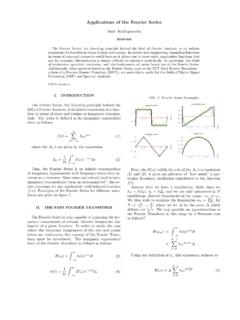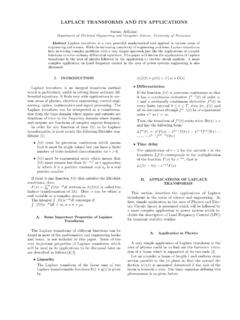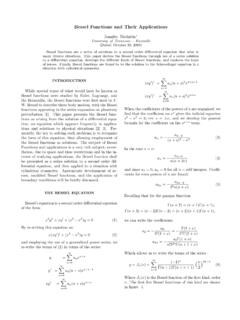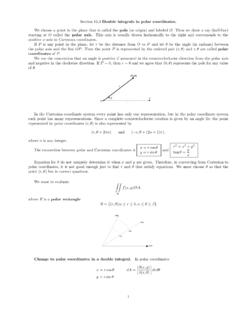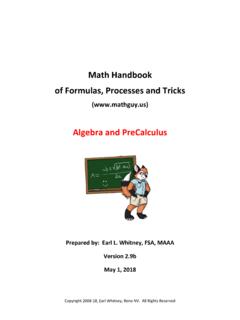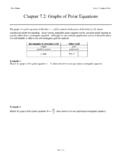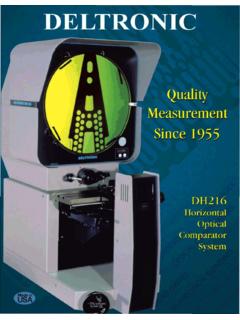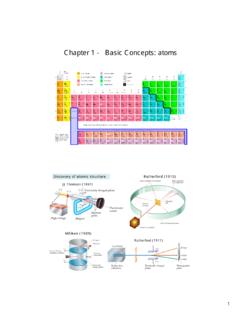Transcription of Beta Function and its Applications - Dagotto Group …
1 Beta Function and its ApplicationsRiddhi D.~Department of Physics and AstronomyThe University of TennesseeKnoxville, TN 37919, USAA bstractThe Beta Function was rst studied by Euler andLegendre and was given its name by Jacques as the gamma Function for integers describes fac-torials, the beta Function can de ne a binomial coe -cient after adjusting beta Function was the rst known scattering amplitude in string theory, rstconjectured by Gabriele Veneziano. It also occursin the theory of the preferential attachment process,a type of stochastic urn incomplete betafunction is a generalization of the beta Function thatreplaces the de nite integral of the beta Function withan inde nite situation is analogous to theincomplete gamma Function being a generalization ofthe gamma IntroductionThe beta Function (p;q)is the name used by Legen-dre and Whittaker and Watson(1990) for the betaintegral (also called the Eulerian integral of the rstkind).
2 It is de ned by (p;q) =(p 1)!(q 1)(p+q 1)!To derive the integral representation of the betafunction, we write the product of two factorial asm!n! =R10e uumduR10e vvndv:Now takingu=x2;v=y2;som!n! = 4R10e u2x2m+1dxR10e v2y2n+1dy=R1 1R1 1e (x2+y2)jxj2m+1jyj2n+1dxdy:Transforming to polar coordinates withx=rcos ;y=rsin m!n! =R2 0R10e v2jrcos j2m+1jrsin j2n+1rdrd to getm!n! = 2(m+n+ 1)!R =20cos2m+1 sin2n+1 d The beta Function is then de ned by (m+ 1;n+ 1) = 2R =20cos2m+1 sin2n+1 d =m!n!(m+n+1)!Rewriting the arguments then gives the usual formfor the beta Function , (p;q) = (p) (q) (p+q)=(p 1)!(q 1)(p+q 1)!The general trigonometric form isR =20sinnxcosmxdx=12 f12(n+ 1);12(m+ 1)g[1][2][5]3-D Image of Beta Integral:- a(x) =R10ta 1(1 t)x 1dt;is called the Eulerian integral of the rst kind byLegendre and Whittaker and Watson(1990).The solu-tion of this integral is the Beta Function (p+1;q+1):[1][2]The Beta Function evolves from Gamma Function (p;q) = (p) (q) (p+q)=(p 1)!
3 (q 1)(p+q 1)!where signi es the Gamma between the Gamma Function and theBeta Function can be derived as (x) (y) =R10e uux 1duR10e vvy 1dv:Now takingu=a2;v=b2;so (x) (y) = 4R10e a2a2x+1daR10e b2b2y+1db=R1 1R1 1e (a2+b2)jaj2x 1jbj2y 1dadb:Transforming to polar coordinates witha=rcos ;b=rsin (x) (y) =R2 0R10e r2jrcos j2x 1jrsin j2y 1rdrd =R10e r2r2x+2y 2rdrR2 0 (cos )2x 1(sin )2y 1 d = (x+y) (x;y)Hence, rewriting the arguments with the usual formof Beta Function : (p;q) = (p) (q) (p+q):A somewhat more straightforward derivation : (x) (y) =R10tx 1e tdtR10sy 1e sds=R1t=0R1s=0tx 1sy 1e (t+s)dsdtThe argument in the exponential inspires us to em-ploy the substitution =s+t =tThusjJj= 1;where J is the Jacobian of the transformation. Us-ing this transformation, (x) (y) =R1 =0R =0 x 1( )y 1e d d =R1 =0R =0 x 1 y 1(1 )y 1e d d Again, now the comparison to (x;y)leads us to :r= ;q= where the Jacobian is now:jJj=q:This leads to an easy identi cation with the ex-pected result: (x) (y) =R1q=0R1r=0q(rq)x 1q(y 1)(1 r)y 1e qdrdq=R1q=0R1r=0rx 1(1 r)y 1qx+y 1e qdrdq=R10qx+y 1e qdqR10rx 1(1 r)y 1dr= (x+y) (x;y)As the gamma Function is de ned as an integral, thebeta Function can similarly be de ned in the integralform: a(x) =R10ta 1(1 t)x 1dt:Graph of Gamma FunctionThe trignometric form of Beta Function is (x;y) = 2R 20sin2x 1 cos2y 1 d ;R(x)>0, R(y)> it in a form which can be used to developintegral representations of the Bessel functions andhypergeometric Function , (x;y) =R10tx 1(1+t)x+ydt;R(x)>0, R(y)>0.
4 (x;y) =1y1Pn=0( 1)n(y)n+1n!(x+n)where (x)is the gamma Function .The second identity showsin particular (12) =p :Just as the gamma Function for integers describesfactorials, the beta Function can de ne binomial co-e cient after adjusting indices.(nk) =1(n+1) (n k+1;k+1)[2][5]Graph of the Beta Function2 *BetafunctionandStringTheory:-The Beta Function was the rst known Scattering am-plitude in String theory, rst conjectured by GabrieleVeneziano ,an Italian theoretical physicist and afounder of string Veneziano, a research fellow at CERN(a European particle accelerator lab) in 1968, ob-served a strange coincidence - many properties ofthe strong nuclear force are perfectly described bythe Euler beta- Function , an obscure formula devisedfor purely mathematical reasons two hundred yearsearlier by Leonhard Euler. In the urry of researchthat followed, Yoichiro Nambu of the University ofChicago, Holger Nielsen of the Niels Bohr Institute,and Leonard Susskind of Stanford University revealedthat the nuclear interactions of elementary particlesmodeled as one-dimensional strings instead of zero-dimensional particles were described exactly by theEuler beta- Function .
5 This was, in e ect, the birth ofstring Euler Beta Function appeared in elementaryparticle physics as a model for the scattering ampli-tude in the so-called "dual resonance model". In-troduced by Veneziano in the 1970th in order to texperimental data , it soon turned out that the basicphysics behind this model is the string(instead of thezero-dimensional mass-point).[4] *PreferentialAttachmentprocess:-Preferen tial Attachment to a class of processes inwhich some quantity, typically some form of wealthor credit, is distributed among a number of individ-uals or objects according to how much they alreadyhave, so that those who are already wealthy receivemore than those who are not. The principal reasonfor scienti c interest in preferential attachment is thatit can, under suitable circumstances, generate powerlaw distributions of wealth[2].[3] Urn Process and BetaFunction:-A preferential attachment process is a stochastic urnprocess, meaning a process in which discrete unitsof wealth, usually called "balls", are added in a ran-dom or partly random fashion to a set of objects orcontainers, usually called "urns".
6 A preferential at-tachment process is an urn process in which addi-tional balls are added continuously to the system andare distributed among the urns as an increasing func-tion of the number of balls the urns already have. Inthe most commonly studied examples, the number ofurns also increases continuously, although this is nota necessary condition for preferential attachment andexamples have been studied with constant or evendecreasing numbers of (k) =B(k+a; )B(k0+a; 1)Linear preferential attachment processes in whichthe number of urns increases are known to producea distribution of balls over the urns following the so-called Yule distribution . In the most general formof the process, balls are added to the system at anoverall rate ofmnew species for each new urn. EachFigure 1: Probability density FunctionFigure 2:Pareto probability density functions for variouskwithxm= horizontal axis is created urn starts out withk0balls and furtherballs are added to urns at a rate proportional to thenumberkthat they already have plus a constanta> k0.
7 With these de nitions, the fractionP(k)of urnshavingkballs in the limit of long time is given byP(k) =B(k+a; )B(k0+a; 1)fork 0(and zero otherwise), where (x;y)is theEuler beta Function : (x;y) = (x) (y) (x+y)with (x)being the standard gamma Function , and = 2 +k0+amIn other words, the preferential attachment processgenerates a "long-tailed" distribution following a Pareto distribution or power law in its tail. This isthe primary reason for the historical interest in prefer-ential attachment. The species distribution and manyother phenomena are observed empirically to followpower laws and the preferential attachment process isa leading candidate mechanism to explain this behav-ior. Preferential attachment is considered a possiblecandidate for, among other things, the distribution ofthe sizes of cities, the wealth of extremely wealthy in-dividuals, the number of citations received by learnedpublications and the number of links to pages on theworld wide web.
8 [2][3]References:-[1] M. Zelen and in Milton Abramowitzand Irene A. Stegun, eds. "Handbook of Mathemati-cal functions with Formulas, Graphs and Mathemat-ical Tables.[2] Arfken, G. " The Beta Function ." Ch. Mathematical Methods for Physicists,3rd ed. Or-lando, FL: Academic Press, pp. 560-565,1985.[3] Stochastics Processes by Jyotiprasad Medhi.[4] Supersymmetry and String Theory by MichaelDine.[5]BetaFunctionfromTheWolfra mFunctionsSite.[url:- ].

